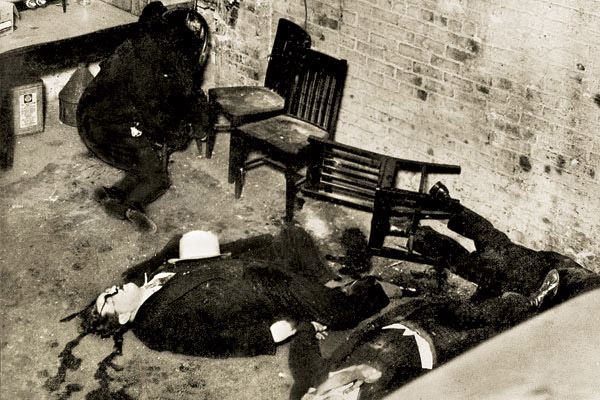
It's Valentine's Day, and the thoughts of Chicagoans turn to… well, mob hits, from what I can tell.
Which is okay by me. There was a little uptick in interest of an excerpt from Get Capone by Jonathan Eig, who's been writing a sports column for us and is heading up a new Chicago sports website soon. It's a fascinating piece of Chicago history, in which Eig, in his role as Capone biographer, sets out to explain why the St. Valentine's Day Massacre happened. Working off a letter sent by Chicagoan Frank T. Ferrell to J. Edgar Hoover, recently discovered in the FBI archives, Eig offers "the most logical and satisfying solution to the crime ever presented."
Farrell’s letter resolves many of the mysteries surrounding the massacre. It helps explain why so many of Moran’s men were in the garage that morning, why they were dressed well, and why they never fired their guns when faced by their intruders. It also offers a clear motive—one with enough emotional power to explain the fury of the attack. It may even account for why the investigation of the crime went nowhere.
The other day John Kass was lamenting that the city sticker-gang sign story was getting all the attention, while Michael "The Large Guy" Sarno (someone, I forget who, said something like "you can tell the Chicago Outfit is doomed because they've completely run out of nicknames") was sentenced to 25 years in prison with hardly a peep. I thought the gang sign story was interesting because I love semiotics, but he had a point—Chicago has a very rich recent organized-crime history, but people tend to assume it's basically over.
Yet Capone, and an 83-year-old massacre, continue to fascinate. Along those lines, I found one of what I'm sure are many posts about the St. Valentine's Day Massacre—at, of all places, Wired's "This Day in Tech," a series devoted to significant advances in scientific and technological paradigms. Which meant I had to click on it. And it's a neat argument:
The art of the gangland slaying takes a quantum leap when mobsters working for Al Capone use the cutting-edge technology of the day — the Thompson submachine gun — to wipe out a rival gang in a garage on Chicago’s North Side.
The St. Valentine’s Day massacre wasn’t the first time a mobster used the Tommy gun in a rub-out, but the slaughter — seven men were killed — was unprecedented and therefore shocking, even by jaded Chicago standards.
It might be pushing it a bit. As Stephen Holbrook—a veteran gun-rights advocate who represented the NRA in McDonald v. Chicago—writes in a brief history of Prohibition-era gun laws, Capone first employed the tommy gun in a 1926 killing:
As Congress debated the postal ban [a ban on mail-order handguns, according to Holbrook the "first federal legislation regulating firearms"], the Chicago gangs that had arisen after passage of the Volstead Act discovered the machine gun. Al Capone's first use of the Tommy gun in 1926 left a likely trio dead: a bootlegger, a politician, and William McSwiggin, assistant state's attorney. Congress again jumped into the fray. Rep. Hamilton Fish of New York, proposing in 1930 a machine-gun ban "copied word for word from the prohibition law," conceded that you have "to stretch the constitutional provisions to a considerable degree."
As the epic Homicides in Chicago 1870-1930 site points out, the killing of McSwiggin was also a significant turning point in the Beer Wars (do click around on their PDFs, they're fascinating). The St. Valentine's Day Massacre didn't alone create the gangster panic, and it doesn't alone explain the massacre's hold on our imagination, but I found the tech angle compelling nonetheless. And speaking of that intersection between the allure of romance, gangsters, and tommy guns, you just missed a chance to pick up Bonnie and Clyde's old .45 caliber Thompson submachine gun, just $130,000 for that special someone.
Photograph: Chicago Tribune



